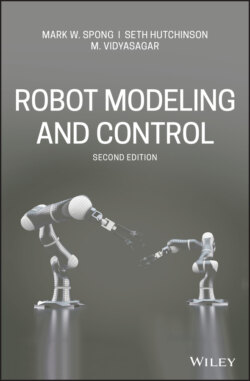Читать книгу Robot Modeling and Control - Mark W. Spong - Страница 62
2.4.3 Rules for Composition of Rotations
ОглавлениеWe can summarize the rule of composition of rotational transformations by the following recipe. Given a fixed frame o0x0y0z0 and a current frame o1x1y1z1, together with rotation matrix relating them, if a third frame o2x2y2z2 is obtained by a rotation performed relative to the current frame then postmultiply by to obtain
(2.22)
If the second rotation is to be performed relative to the fixed frame then it is both confusing and inappropriate to use the notation to represent this rotation. Therefore, if we represent the rotation by , we premultiply by to obtain
(2.23)
In each case represents the transformation between the frames o0x0y0z0 and o2x2y2z2. The frame o2x2y2z2 that results from Equation (2.22) will be different from that resulting from Equation (2.23).
Using the above rule for composition of rotations, it is an easy matter to determine the result of multiple sequential rotational transformations.
Example 2.8.
Suppose R is defined by the following sequence of basic rotations in the order specified:
1 A rotation of θ about the current x-axis
2 A rotation of ϕ about the current z-axis
3 A rotation of α about the fixed z-axis
4 A rotation of β about the current y-axis
5 A rotation of δ about the fixed x-axis
In order to determine the cumulative effect of these rotations we simply begin with the first rotation Rx, θ and pre- or postmultiply as the case may be to obtain
(2.24)
